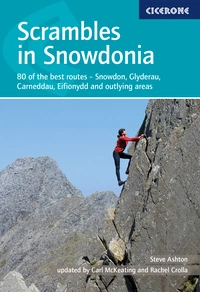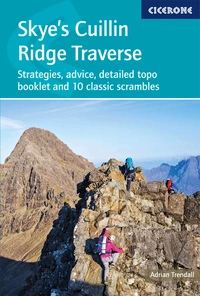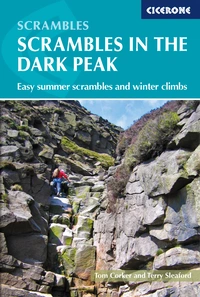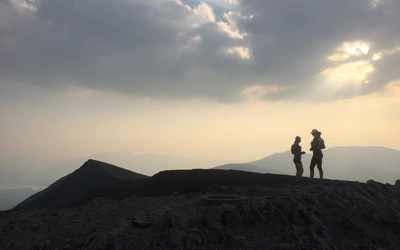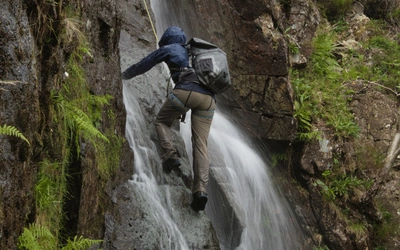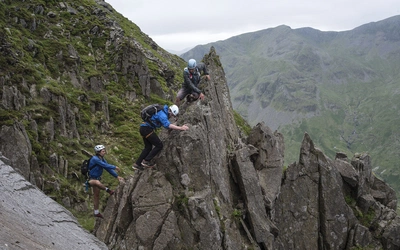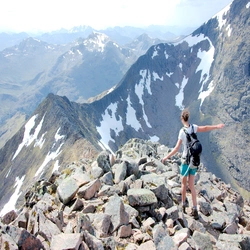What is scrambling?
The sport of scrambling is not new. In fact, the ascent of the majority of Alpine peaks by their normal route involves some scrambling. But what is it? John Fleetwood, author of Cicerone's Scrambles in the Lake District explains.
For me, scrambling offers the perfect combination of continuous movement and unfettered climbing in a mountain environment. It is a very basic activity that offers adventure, physical activity and mental concentration.
Lakeland pioneer Harry Griffin clearly identified with this, saying: 'The Lake District teems with opportunities for modest adventure away from the track… those I have introduced to various unconventional scrambles and climbs have all become addicts'1.
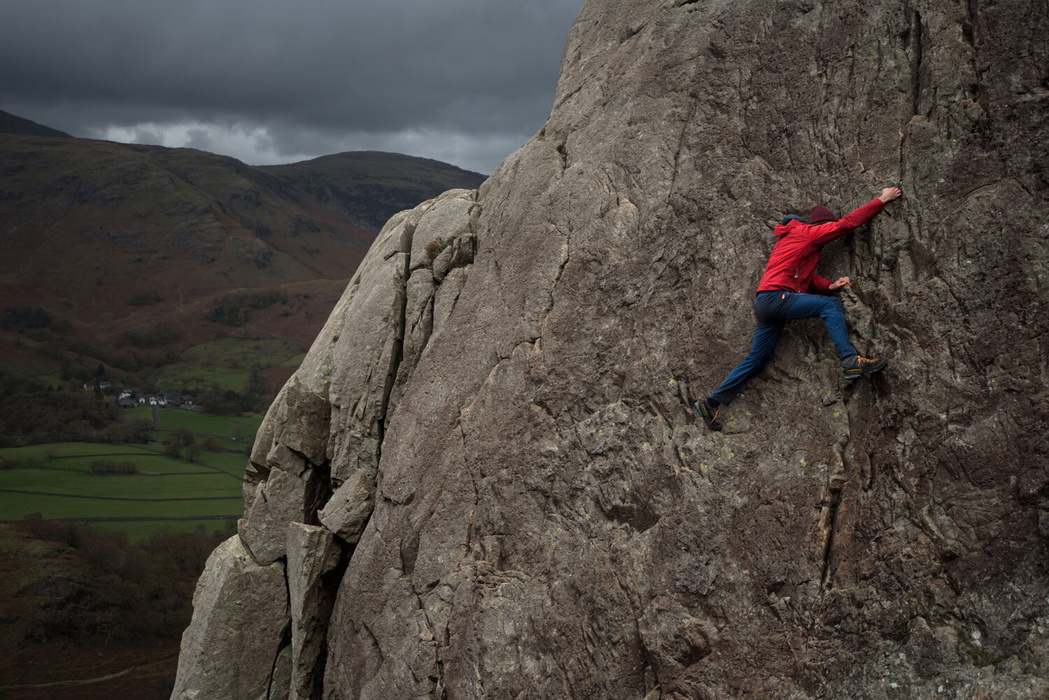
Scrambles in the Lake District - South
Langdale, Coniston, Eskdale, Patterdale & High Street
£18.95
Guide to 106 scrambling routes climbing the rocks and ghylls of the English Lake District, covering the southern area including Langdale, Coniston and Eskdale. Routes range from grade 1 to V Diff (use of a rope is recommended for grade 2 and above) and can be linked to form 24 longer outings. With advice on equipment and safety.
More informationMany of us have become addicts in Harry’s mould.
The ascent of easy rocks where hands may be used is naturally satisfying and has always been enjoyed by mountaineers. Many of the Lake District scrambles have been known since Victorian times and many have been used by generations of climbers
In 1802 Coleridge descended Broad Stand in the Lake District, while an Ennerdale shepherd, John Atkinson, climbed Old West route on Pillar Rock in 1826.
The first ascensionist of the Napes Needle in 1886, WP Haskett-Smith, was very much a scrambler at heart: 'We were rather heretical in our attitude to the use of the rope not having one ourselves. In the gall of bitterness, we classed ropes with spikes and boulders, as a means by which bad climbers could go where none but the best climbers ought to be'.2
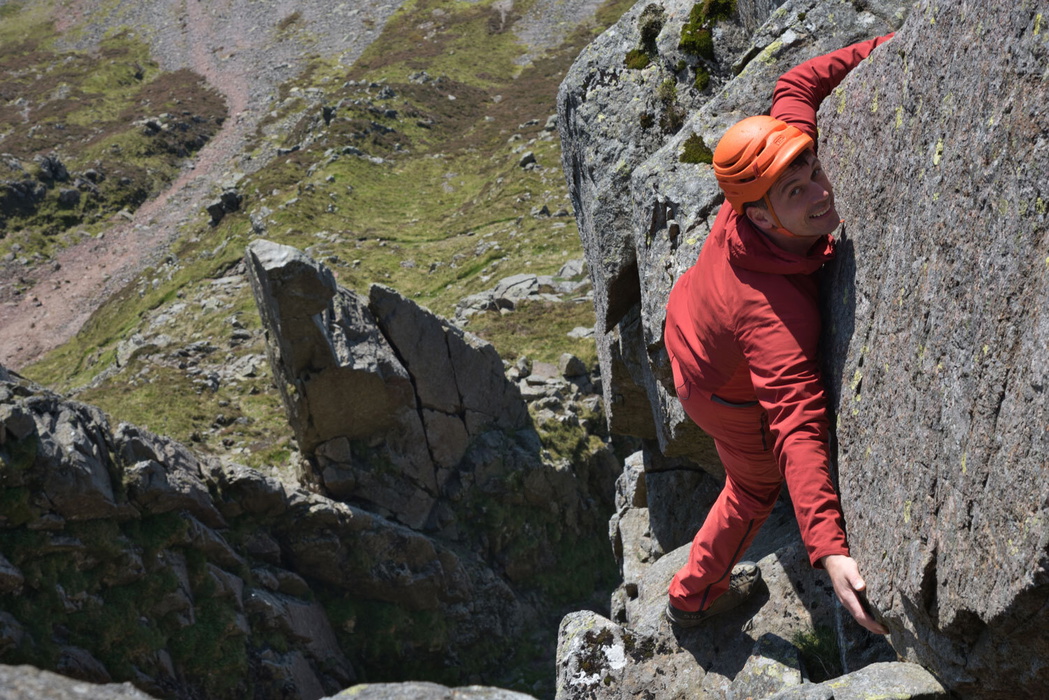
The adventure of scrambling is exemplified by the first ascent of Old West on Pillar Rock when the only precaution taken was ‘to place pieces of moss on the track by which he ascended'.3

I regard scrambling to be an ascent of rock where the hands are necessary for progress, usually with comforting holds. There may also be a few difficult rock moves required in order to overcome an obstacle but, unlike modern rock climbing, requires that the scrambler does not fall. It is a return to the days of the Victorian pioneers!
Where scrambling becomes rock climbing
It is difficult to know just where to draw the line and recognise where scrambling becomes rock climbing. Some consider scrambling ends when you need a rope, but this is so much a personal choice that one person's easy scramble is another's frightening climb.
A recommended book, which delves into the philosophy of the subject, is Colin Mortlock's The Adventure Alternative (Cicerone Press), now out of print. Mortlock has many thought-provoking theories and divides adventure into bands.
Every individual has their adventure threshold, the boundary between intense enjoyment and command of the situation, and fear that could result in misadventure. For some individuals that threshold is quite low; others need a much more gripping situation to savour the adventure. Find your threshold and keep within your own limits.
Many rock climbers use scrambles as a means of salvaging something exciting on a day of poor weather. However, in bad conditions the crags are treacherously slippery and many climbers have got more than they bargained for, so the seriousness of these routes should not be underestimated.
Types of scrambling
Although some scrambles take the form of extended rock buttresses, in areas like the Lake District scramblers should not expect extended rock climbs – more a series of rock incidents in a day on the hills. On many of the routes it is a simple matter to bypass most of the rock and reduce the outing to a steep walk. You can also often choose to make the route more difficult by seeking steeper rock problems.
And then there’s gill scrambling. Gill scrambling is something of an acquired taste that some find hideous and others consider to be the very best scrambling. It is the very antithesis of modern rock climbing – vegetated, slippy and often poorly protected.
Yet gills are deeply beautiful with an energy created by the rushing water. There are very few poor gill scrambles, in contrast with crag scrambles, where scrappy routes abound.
Harry Griffin, a pioneer of gill scrambling, sums it up nicely: 'Perhaps you could regard gill climbing as harking back to the old days before guide books, when people did their own exploring in out-of-the-way places. Entering a gill you have never seen at close quarters is deliciously uncertain.'4

The character of scrambles can vary greatly. At one end of the scale, there are short, near-to-the-road scrambles that make a pleasant addition to a longer route or a place for a play. At the far end of the spectrum, there are exploratory excursions into lost worlds in which any self-respecting Victorian might have revelled – forgotten places in high mountain lairs, where loose rock, copious vegetation and a north face atmosphere are par for the course.
I really enjoy the total freedom of solo scrambling, but the dangers are many. It is so easy to stray into unforeseen difficulties where retreat is hazardous, especially if the rock is slippery. You need a lot of experience to judge the actual difficulty of the route when it can look deceptively easy. Only climb up what you can climb down, or know that you can continue or escape above a crux.
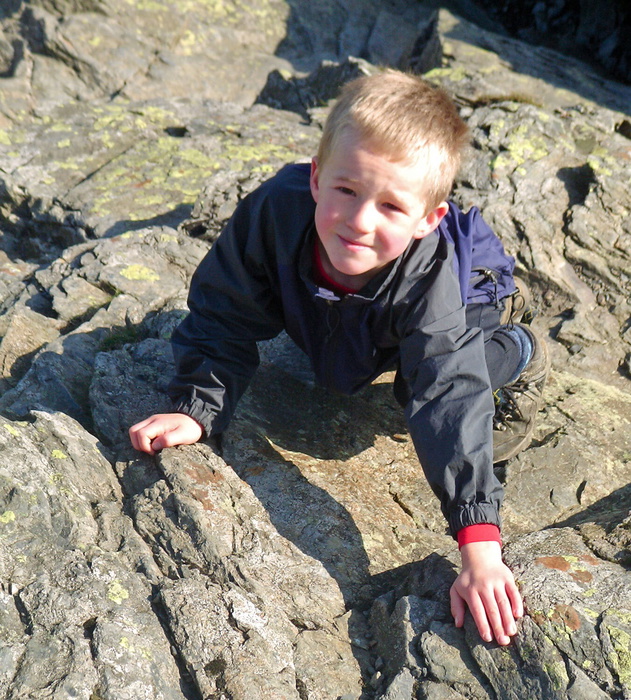
Scrambling with children
Children are natural scramblers and often take to scrambling with considerably more enthusiasm than a walk.
Having taken my son on scrambles at a very early age, I am a great advocate of introducing children to scrambling.
However, they do not possess experience or sound judgement. They need constant supervision and should be short-roped at all times.
I recommend using a climbing belt/harness or even a doubled up sling and karabiner, and short-roping the child on a long sling or hillwalker’s rope.
Equipment
One of the beauties of scrambling is that it requires little specialist equipment. For many scrambles normal mountain clothing, a rucksack, compass, headtorch, first aid kit, food, waterproofs and a map are all that is required. However, the following notes may prove helpful and are derived from experience in the context of the particular situations encountered in the Lake District.
Footwear
I have a personal preference for fell running or approach shoes since these are comfortable, grip well on the rock and shed water as fast as they get wet. However, many prefer more rigid shoes. The best have some lateral rigidity in the sole. Avoid dangerous, cheap bendy boots sold in many non-specialist shops, or trainers. It may be tempting to use specialist rock boots on the climbing scrambles, but smooth soles are dangerous on grass, which is often encountered on a scramble. Thick woollen socks worn over shoes or boots are pretty essential for certain gill scrambles and I tend to take them on all gill scrambles, since the extra grip provided makes them more enjoyable.

Clothing
Bring sufficient warm clothing to cope with moving slowly on wind-blasted tops. A change of clothes may be a good idea, if continuing after a dowsing in a wet gill. As someone who suffers from cold hands, I often take two pairs of gloves – the spare pair is useful if the first gets wet (and then cold). Fingerless or thin gloves are best for climbing on more tricky rock, with a thicker pair for walking.
Rucksack
Any daysack will do but a chest strap and a good hip belt make the sack much more stable. Some gills are like standing in a power shower, so a rucksack cover and waterproof liners are a very good idea.
Helmets
Some of the scrambles take you into very loose terrain where the danger of rockfall is very real. It’s therefore highly advisable to take a lightweight helmet wherever a risk of loose rock exists. At the very least it will stop you from bumping your head as you look up!
Harness and climbing rack
Use a lightweight harness that is easy to put on and take off. Treat the harder scrambles as easy Alpine climbs without the snow, i.e. a belay device, a few slings and karabiners, a small selection of medium-sized nuts and some abseil cord just in case.
Rope
Although most scrambling is done unroped, a rope should be taken and used when the leader deems that the less confident may need assurance or to protect a particularly difficult pitch such as may occur on Grade 3 routes or above. On routes designated as climbing scrambles, all but the most confident and experienced should take a rope and small rack.
A short rope is easier to handle and as pitches are generally short, this is likely to be more than sufficient. A 30m half-rope is best, or in some instances, a hillwalkers’ safety rope may suffice to give the second confidence. A full rope is safest on climbing scrambles.
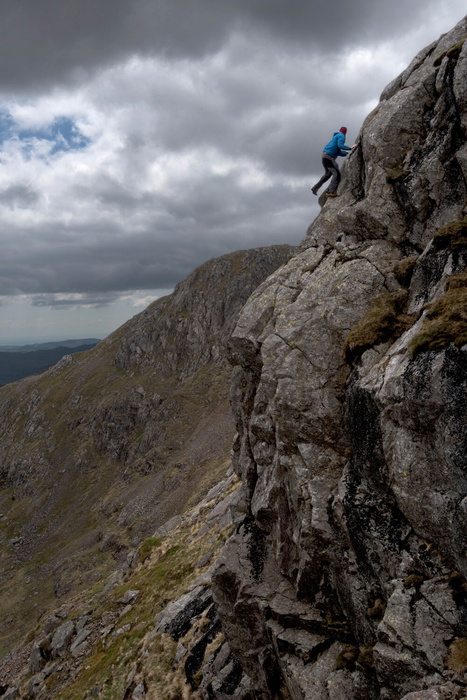
Grading
Grading is inherently subjective but gives a guide as to the difficulty of the route. Minus (-) and plus (+) notations may be used to augment the 1-3 grades to add further granularity. Rock climbing grades are used for routes commonly climbed as roped rock climbs.
The grades apply to ascents in good dry conditions. Wet rock, particularly on the crags, can increase the grade considerably or render a scramble extremely hazardous.
1 A straightforward scramble, with little or no route-finding difficulty. The described route takes the most interesting line, which can usually be varied or even avoided at will. Generally, the exposure is not great, but even so, great care must be taken to avoid a slip.
2 Contains longer and more difficult stretches of scrambling, and a rope may be useful for ensuring safety for inexperienced or nervous scramblers. Although individual sections of the scramble can usually be avoided, these sections may be inescapable once the scramble is underway. Some skill in route finding is required to follow the described line.
3 A more serious proposition, only to be undertaken by competent parties. Escape is difficult. A rope is advisable for safety on exposed passages and for some pitches of easy rock climbing. The routes require a steady leader with the ability to judge how the rest of the party are coping with the situations, and a rope should be used wherever the safety of an individual is in doubt.
3S A particularly serious outing, often involving poor rock or vegetation, and may include steep pitches of rock climbing. Recommended only for experienced, competent climbers who will almost certainly use a rope on key pitches. Escape is difficult.
M Moderate rock climb
D Difficult rock climb
VD Very Difficult rock climb
The grade is usually accompanied by a star rating that indicates the overall quality of the route considering not just the scrambling itself, but situation, continuity and length.
No Stars Not particularly meritorious in its own right, but worth including as part of a day’s outing.
* Worth climbing but may be discontinuous, short or lacking in continuous interest
** A route of more continuous interest and a good line
*** A classic route with continuously interesting scrambling that is based on a good line
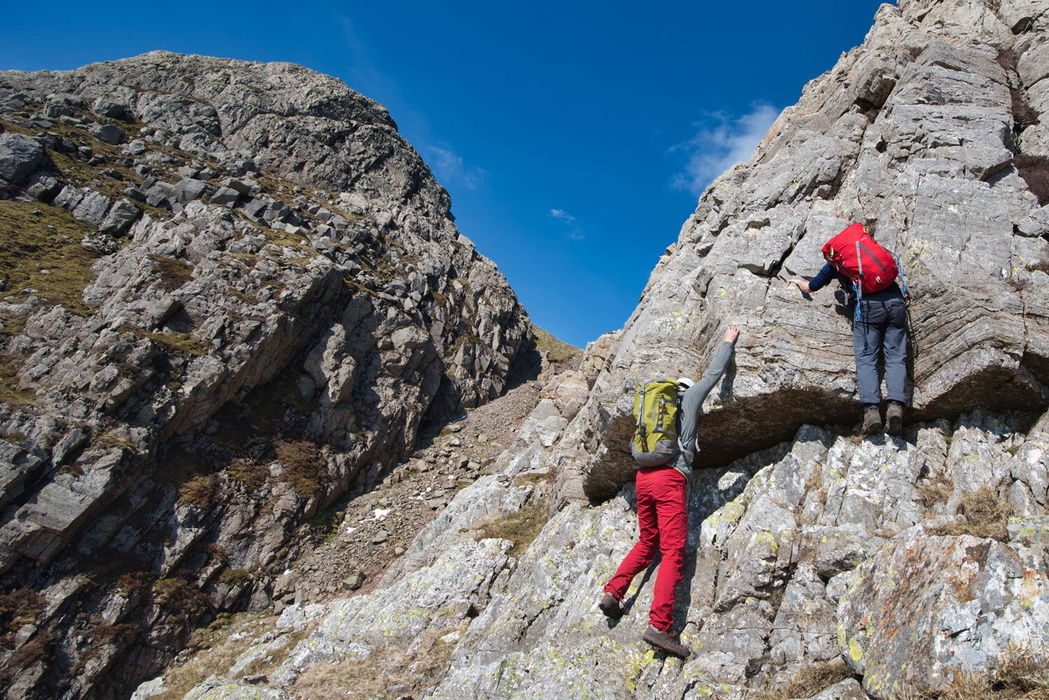
Dangers and how to avoid them
Scrambling is an adventure sport, which implies that it is dangerous. It is worth remembering that unroped scrambling in exposed situations is potentially the most dangerous of all mountaineering situations in which you must return to the maxim followed by rock climbers before the advent of modern gear – YOU MUST NOT SLIP.
Loose rock is quite common on scrambles, especially those graded 3S. Test each hold carefully, especially when pulling on that convenient jug – it may just come flying out and you with it. Wear a helmet when sheep or other people may knock stones on to your head, even on relatively easy scrambles.
Know when to retreat. Wet or icy conditions can transform an easy scramble to a skating rink. Assess the conditions before you start and don’t be afraid to change your plans. There are three times to make a re-assessment – before you set out, before your leave your car or starting point, and before you start your route. Be prepared to alter your route at any stage. If you leave it until you are on the route, it may be too late.
Build experience gradually. Adventurous walkers who are using this book should tackle the easiest routes only in good conditions. Sample several routes at a given grade before you move up to the next one and go with someone who is more experienced than you until you can make your own judgements.
To sum up, the British Mountaineering Council's participation statement should be heeded.
‘The BMC recognises that climbing, hillwalking and mountaineering are activities with a danger of personal injury or death. Participants in these activities should be aware of and accept these risks and be responsible for their own actions and involvement.'
1 Adventuring in Lakeland, AH Griffin, 1980
2 Alan Hankinson, The First Tigers, 1972
3 OG Jones, Rock Climbing in the English Lake District, 1900
4 Adventuring in Lakeland, AH Griffin, 1980



